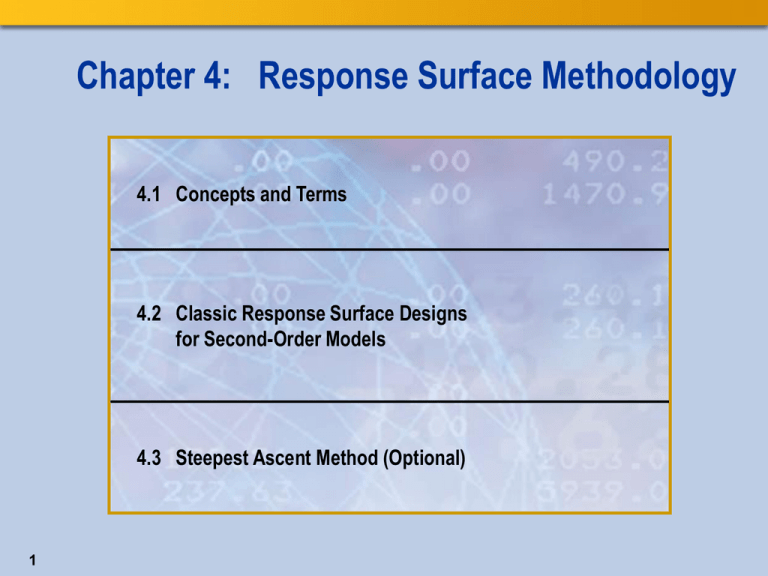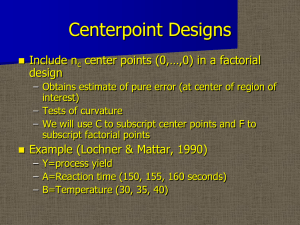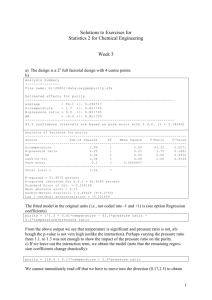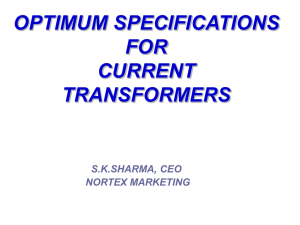Response Surface Methodology
advertisement

Chapter 4: Response Surface Methodology
4.1 Concepts and Terms
4.2 Classic Response Surface Designs
for Second-Order Models
4.3 Steepest Ascent Method (Optional)
1
Chapter 4: Response Surface Methodology
4.1 Concepts and Terms
4.2 Classic Response Surface Designs
for Second-Order Models
4.3 Steepest Ascent Method (Optional)
2
Objectives
3
Understand response surface methodology and its
sequential nature.
Distinguish among different kinds of optima.
Illustrate different types of surfaces and relate those
surfaces to model equations.
Response Surface Methodology
4
Response surface methodology (RSM) uses various
statistical, graphical, and mathematical techniques to
develop, improve, or optimize a process.
The most frequent applications of RSM are in the
industrial area, where several predictor variables are
used to predict some performance measure or quality
characteristic of a product or process.
Sequential Nature of RSM
5
You used designed experiments to determine what
factors are important in determining the qualities of
your product or the results of your process.
Now you want to find factor settings or a factor region
that optimize your response or responses.
Finding these factor settings or factor region is an
iterative process that utilizes designs discussed in the
previous chapters and designs to be discussed in this
chapter.
New Purpose Requires New Designs
At this point, you need more detailed information than the
screening design could give you; optimum conditions are
difficult to find using only screening designs. For this, you
need more data in order to add new effects to your model.
The design you select and the new data points you add
depend on the model you want to fit.
To estimate
linear parameters, you could use a two-level fractional
factorial design of resolution ≥ 3.
cross-product parameters, you could use a fractional
factorial design of resolution ≥ 5.
quadratic parameters, data for at least 3 levels of each
factor is required.
6
The Number of Levels
Model adequacy requires testing (m+1) levels of a factor
with order m polynomial effects.
Linear effects, m = 1, require two factor levels.
Quadratic effects, m = 2, require three factor levels.
Effects greater than second-order, m ≥ 3, are unusual.
You can avoid a large number of levels by restricting
the factor ranges.
7
Center Points
Center points
provide a third level to support a quadratic model
are positioned symmetrically between the ends of the
test range {-1, 0, +1}
are a common element in response surface designs
are focused replication to estimate pure error
add to screening designs to provide additional
information.
8
9
4.01 Multiple Answer Poll
Which of the following statements are true about center
points?
a. They are positioned halfway between the low and high
settings.
b. They are coded as 0.
c. They are commonly found in response surface
designs.
d. They are used to estimate pure error.
10
4.01 Multiple Answer Poll – Correct Answers
Which of the following statements are true about center
points?
a. They are positioned halfway between the low and high
settings.
b. They are coded as 0.
c. They are commonly found in response surface
designs.
d. They are used to estimate pure error.
11
General Optimum Response
You might have a general objective in mind for your
response.
More is better (maximum).
Less is better (minimum).
Target is better (range of response values).
12
Specific Acceptable Response Values
You might have a specific objective for your goal. For
example:
Yield should be at least 90%.
Impurity must be less than 5 mg/L.
Final acidity is best at 4.5 0.2 pH.
13
Satisfy More Than One Goal
You might have more than one response, and each
response has a unique goal.
Some responses have more demanding specifications
than other responses.
Some responses are more important than other
responses.
The best factor settings are a trade off of all of the
response goals.
14
15
4.02 Multiple Choice Poll
What is the most common goal for the processes at your
business?
a. To maximize
b. To minimize
c. To hit a target
16
Design Under Factor Constraints
You might also have a factor with specifications, or a
constraint. Such specifications or constraints might:
Account for physical limitations.
Minimize costs or safety risks.
Manage inventory or control cost.
You want to satisfy this constraint when you find the
optimum settings.
17
The Response Surface and its Model
Your response usually depends on more than one factor.
The shape of the response as a function of two or more
factors defines a surface.
You want to explore the surface for the optimum
response without testing every possible point.
This true response model that describes the surface is
usually unknown.
A smooth interpolating function is usually used, and it
generally includes quadratic and interaction effects.
Y 0 i X i i j X i X j ii X
18
2
i
RSM Models For Two Factors
Screening
y=0 + 1x1 + 2x2 + 12x1x2 +
Steepest ascent
y=0 + 1x1 + 2x2 +
Optimization
y=0 + 1x1 + 2x2 + 12x1x2 + 11x1 + 22x2 +
2
19
2
Good Design
A good design is both effective and efficient.
An effective design enables you to obtain sufficient
data to fit an interpolating model that provides
unbiased predictions with sufficient precision.
An efficient design enables you to obtain the most
precise estimates for a given budget on the number of
runs.
20
Shape of the Response
This demonstration illustrates the concepts discussed
previously.
21
22
4.03 Quiz
Match each surface type with its graph.
A.
B.
C.
D.
23
E.
1.
2.
3.
4.
5.
Planar Surface
Quadratic Surface
Saddle Surface
Ridge Surface
Twisted Surface
4.03 Quiz – Correct Answer
Match each surface type with its graph.
A.
B.
C.
D.
E.
1-A, 2-B, 3-D, 4-C, 5-E
24
1.
2.
3.
4.
5.
Planar Surface
Quadratic Surface
Saddle Surface
Ridge Surface
Twisted Surface
25
Chapter 4: Response Surface Methodology
4.1 Concepts and Terms
4.2 Classic Response Surface Designs
for Second-Order Models
4.3 Steepest Ascent Method (Optional)
26
Objectives
27
Understand properties of Box-Behnken and Central
Composite designs.
Generate and analyze a Box-Behnken design.
Generate and analyze a Central Composite design.
Box-Behnken Design
The Box-Behnken design
incorporates three levels (coded –1, 0, +1)
has points that are vertices of a polygon and
equidistant from the center
avoids extreme points
(for example, [+1, +1, +1])
does not utilize a screening run
is the smallest classic response surface design for
fewer than five factors
has uniform blocks: each level of each factor is in each
block an equal number of times and the center points
are evenly divided among the blocks.
28
Box-Behnken Design Example
29
The objective of an experiment is to reduce the
unpleasant odor of a chemical product. The response
variable is Odor, and it is believed that a secondorder model is required.
The factors are temperature (Temp) with a range of
40-120, gas and liquid ratio (GL Ratio) with a
range of .2-.7, and packing height (Height) with a
range of 2-6.
Box-Behnken Design Example
30
There are 3 continuous factors (Temp, GL Ratio,
and Height). For a Box-Behnken design, there will be
15 runs: 12 to examine all possible combinations of low
and high for each pair of factors (with the third factor at
the center) and 3 center points.
The plot shows the position of the design points.
Box-Behnken Design
This demonstration illustrates the concepts discussed
previously.
31
32
4.04 Quiz
Match each graph with its name.
A.
C.
33
B.
1. Surface Plot
2. Contour Plot
3. Prediction Profiler
4.04 Quiz – Correct Answer
Match each graph with its name.
A.
C.
B.
1. Surface Plot
2. Contour Plot
3. Prediction Profiler
1-B, 2-C, 3-A
34
Central Composite Design
X
X
X
X
X
X
35
X
X
The CCD design
incorporates five levels
(coded –α,-1, 0,+1,+α)
shares screening runs
has axial points (±α) for
one factor and 0 for all
other factors
is the largest factorial
design for 3 factors and
the smallest for 5 or
more factors
has points that form a
cube plus a star
Central Composite Design Example
36
Recall the experiment to determine which factors are
important to determine Seal Strength for a bread
wrapper. The experimenter decides to run a CCD to
understand the shape of the response surface and to
find an optimum setting for these factors.
The factors are % Polyethylene with a range of
85-95, Cooling Temperature with a range of
120-140, and Sealing Temperature with a
range of 220-240.
Central Composite Design Example
37
There are 3 continuous factors (% Polyethylene,
Cooling Temperature, and Sealing
Temperature). For a CCD design with uniform
precision, there will be 20 runs: 8 from the 23 design,
6 axial points, and 6 center points.
The plot shows the position of the design points.
Central Composite Design
This demonstration illustrates the concepts discussed
previously.
38
39
4.05 Multiple Answer Poll
Which of the following are properties of the Box-Behnken
design?
a. Avoids extreme design points
b. Incorporates axial points
c. Is rotatable or nearly rotatable
d. Supports screening runs
e. Is the smallest classic response surface design for
fewer than 5 factors
f. Is a spherical design
40
4.05 Multiple Answer Poll – Correct Answers
Which of the following are properties of the Box-Behnken
design?
a. Avoids extreme design points
b. Incorporates axial points
c. Is rotatable or nearly rotatable
d. Supports screening runs
e. Is the smallest classic response surface design for
fewer than 5 factors
f. Is a spherical design
41
Exercise
This exercise reinforces the concepts discussed
previously.
42
43
4.06 Quiz
The Prediction Profiler output from the exercise is below.
Examine the solutions for the three variables. Which
variable’s solution is problematic? Why?
44
4.06 Quiz – Correct Answer
The Prediction Profiler output from the exercise is below.
Examine the solutions for the three variables. Which
variable’s solution is problematic? Why?
Distance – the solution is problematic because distance cannot be
negative. JMP gave this answer because there was no constraint on
Distance.
45
46
Chapter 4: Response Surface Methodology
4.1 Concepts and Terms
4.2 Classic Response Surface Designs
for Second-Order Models
4.3 Steepest Ascent Method (Optional)
47
Objectives
48
Understand the procedures of the method of steepest
ascent to find an optimum.
Design a sequence of experiments using the method
of steepest ascent.
Stages to Find Optimum
Three stages depict the usual sequence to study a process.
1. Screen important effects: this tells you what factors
are important in the first region of optimization.
2. Optimize factor settings: this is only possible if your
current region of investigation contains the optimum you
seek.
3. Verify optimum conditions: this is done after an optimum
is found.
An intermediate step between steps 1 and 2 might be
necessary to find the right region of optimization.
49
Eyes On the Optimum
50
Visualize the Response
51
Your screening experiment will sample some region
in the possible factor space. This region is anchored
in space by its center; the coded level for every factor
at this point is zero.
Without prior knowledge, the range of factor settings
and the multitude of potential factors result in a large
space to search.
The complexity of your response goals might further
reduce the likelihood that the initial region will contain
the optimum.
Graphs Are Useful Searching Tools
Use graphs to visualize the response during your search.
Prediction Profile plot (1D) is a slice of a contour or a
surface plot.
Contour plot (2D) is a topographical map of the
response surface.
Surface plot (3D) of the response shows the shape of
the response from various angles.
52
Method of Steepest Ascent
The method of steepest ascent
is an iterative process that uses multifactor screening
designs and center points
is based on a search strategy (choose direction and
step size)
accommodates minimizing, maximizing, or targeting
goals.
53
Linear Screening Models
54
The original design space does not contain the
optimum.
If you are not close to the optimum, then quadratic
effects should be small: think of the side of a smooth
mountain.
A linear screening model provides the trajectory
toward the goal.
Steps in the Search Process
55
Screen for the important factors and assess the
location of the optimum.
Determine the direction and step size towards the
optimum from the screening model.
Take uniform steps, i for each factor xi, while the
response improves.
Continue stepping along until there is no further
increase or until a decrease in the response is
observed.
Check the direction and model lack of fit.
Determine the Direction
Consider an example of a two-factor case without
interaction.
The linear model parameters define the path of steepest
ascent.
Y = 0 + 1X1 + 2X2
1 and 2 indicate the change in Y for a one-unit
change in coded X.
The vector {1, 2} points to the optimum from the
origin.
56
Step Size
57
You want to take the largest steps possible to reach
the optimum in the fewest steps, but too large of a
step size might mean that you miss the optimum.
Use engineering and scientific knowledge to weigh
the possibilities, and take some risk.
Replicate if necessary to detect a significant
improvement.
After a Stop
When the response either decreases or no longer
increases, it is either because the maximum response is
in the vicinity or because it is not in the vicinity, but
instead you are on a ridge or at a saddle point.
Therefore you have to decide if you want to stay here and
find the optimum or determine a new path and step size to
continue to search.
To decide, first design a two-level screening experiment
and include center points (and shift the initial origin to the
best stop point), fit a new first-order model, and test for a
lack of fit.
58
Continue or Stay
59
Continue the search if there is no detectable or
significant lack of fit. The maximum response is not in
this region, so you need to determine the new
direction and step size.
Stay if the lack of fit test based on the center points
suggests a quadratic effect in the current region. In
this case, design an experiment to ensure model
adequacy for a response surface model. A central
composite design is a good choice for this sequence.
Caveats for Steepest Ascent
60
The same principles apply if the goal is a minimum
response but in an opposite sense. This is called the
path of steepest descent.
The goal might instead be a target. Stop this search
when the range of the response includes the target.
The method of steepest ascent is aggressive. Smaller
adjustments can be used safely to maintain an
optimum response. This method is known as
evolutionary operation (EVOP).
Path of Steepest Ascent for Yield Example
61
A chemical engineer wants to maximize the Yield
of a process.
Two factors have been determined as important:
Reaction Time and Reaction
Temperature.
Currently the process is completed in about 35
minutes at a temperature of about 155 degrees.
Method of Steepest Ascent
This demonstration illustrates the concepts discussed
previously.
62
63




